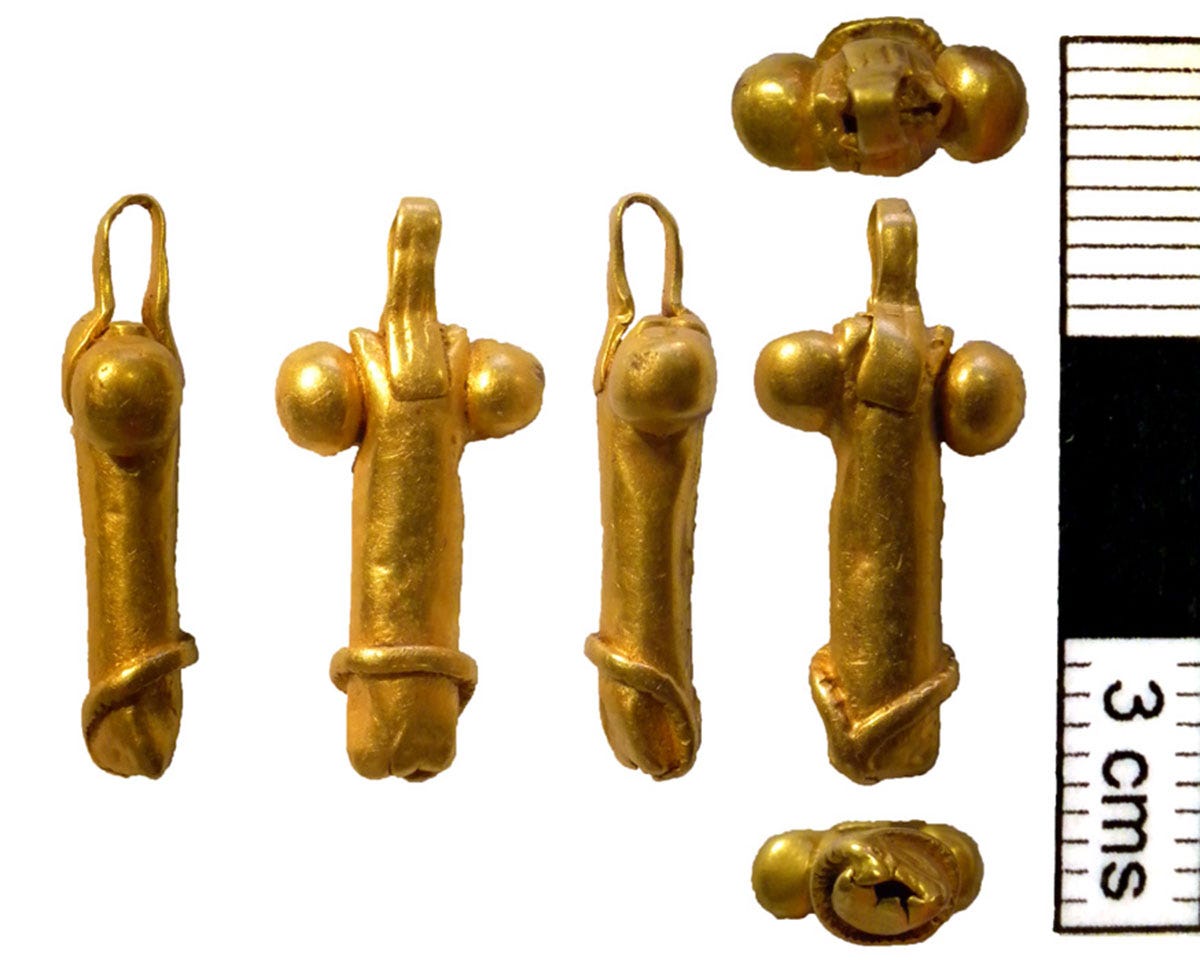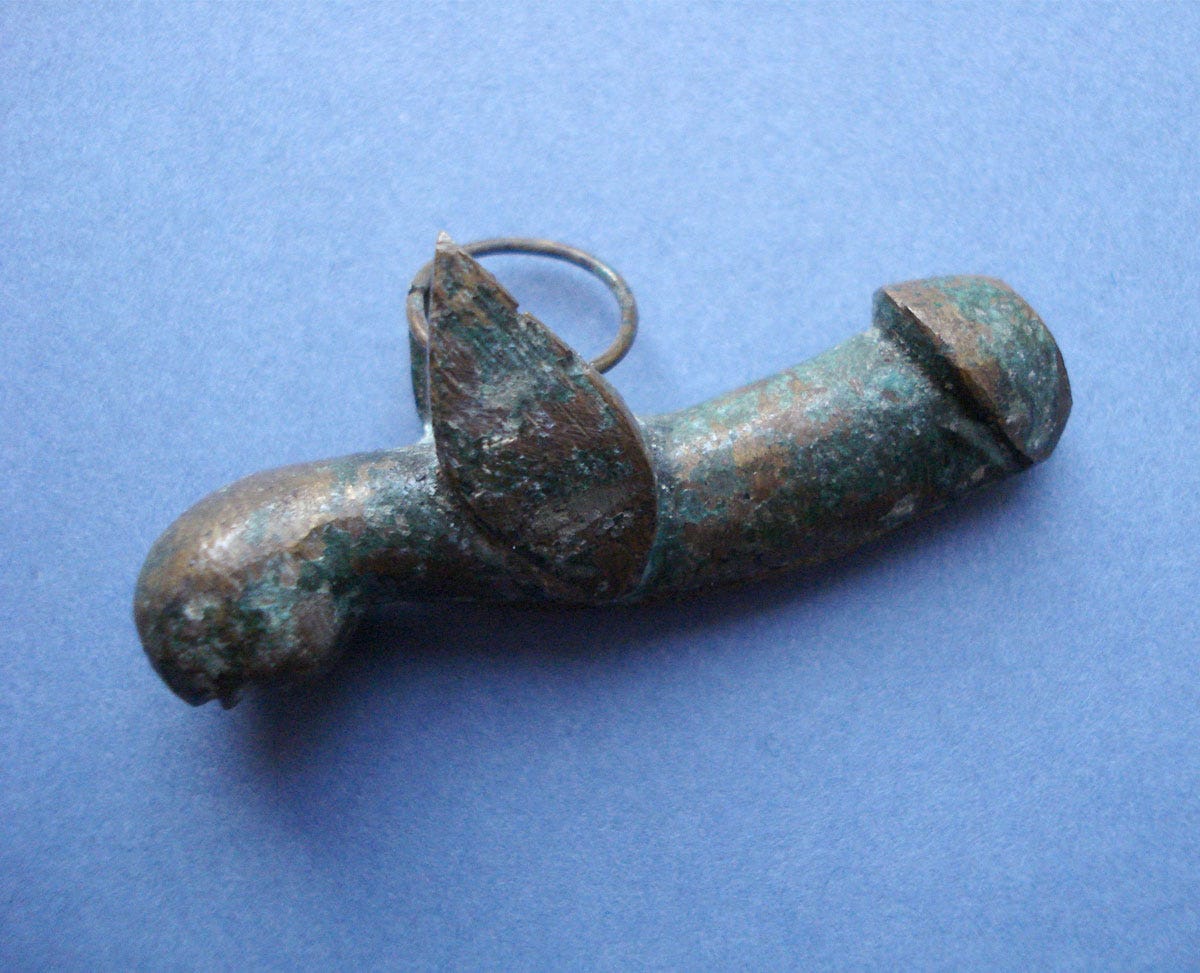Issue 50: how the Romans kept bad luck at bay
The (NSFW-ish) practice of preventing the evil eye from causing harm through rude iconography.
Welcome to Born Free Press, a fortnightly newsletter delivering a free-range collection of interesting stories for interested people. Currently focusing on quirks and curiosities from the UK’s history.
One of the things that stuck out to me on my first visit to the Museum of London many moons ago (and has remained stuck in my memory since) were the Roman phallic amulets.
The interpretation on the wall explained: ‘Representations of male genitals were used as charms against the evil eye and as signs of good luck.’
History, humour, and positive vibes – it ticks the boxes for me.
But along with thinking: ‘It’d be great if they sold replicas of these in the gift shop’ (which they didn’t), I thought: ‘But why a penis?’ and then: ‘Is it some kind of patriarchy thing?’

The evil eye – known as ‘oculus malus’ in Latin – was the ancient embodiment of bad luck. One of the ways to dispel it was to catch its gaze.
And as Adam Parker, archaeologist and museum curator, explained to me, phalli were the perfect distraction because “the sight of a disembodied erect phallus was weird and unusual”.
But also: “Partly it's a result of a patriarchal society. Bluntly, the idea that penises are super powerful and so made mythological.”
Phallic imagery was popular in Roman society and has been found on buildings and pottery, in mosaic designs, as figurines and wind chimes, and – as I saw at the Museum of London – worn as jewellery.
Phallic amulets were known as ‘fascinum’ in Latin, a nod to their ability to fascinate the evil eye. Their most common form was a pendant that could be worn to protect an individual.
Parker did his PhD research on magic in Roman Britain and recorded hundreds of phallic pendants. He says: “Phallic amulets were imported with the earliest phases of the Roman invasion of Britain in the mid-40s AD and remained in use in the province until the end of the 4th Century AD. They were used for a long time by a diverse section of Romano-British society.”
The Museum of London examples were found in the Walbrook Valley (in the City of London, along what is now the subterranean River Walbrook) and are made of iron and bronze.
Copper alloy is one of the most common materials used for pendants. But even more impressive are the rarer examples made of gold.
The brighter and shinier the pendant, the better for catching the gaze of the evil eye.
One stand-out example was found in 2011 in Norfolk, in the east of England, and is now part of the Lynn Museum collection.

And excitingly – the museum sells replicas in its gift shop. They commissioned artist Sue Heaser to create souvenirs in solid silver, including a gold-plated variation to match the original. Heaser describes her replica as a “micro sculpture” and said: “those Roman craftsmen were amazing”. (I called the museum yesterday to check they still sell them, and they told me they had at least one in stock.)

There’s also evidence that Roman people believed multiple or more elaborate phalli were better than (a regular) one. Adding wings, legs, and extra appendages made them even more fantastical and evil eye-catching, and therefore even more effective.
And so, we get artifacts like this:


Parker’s favourite example builds on the idea of more is more effective by combining a phallus with the ‘manus fica’ (fig sign), a protective hand gesture.

He says: “The ancient symbol of the ‘manus fica’ – the thumb beneath the forefinger – was a slightly rude, but protective gesture against evil. On fist-and-phallus pendants one end is a phallus and the other is a hand making this symbol. It's a combination of two different amulets together – double the magic!”
So, these amulets were like giving the evil eye a big ‘F you’ through rude iconography and/or gesture.
Indeed, Parker says: “Phalli are easy to depict in art and recognisable when divorced from the body in a way that many other ancient rude symbols were not – so it had that in its favour.”
And may the good vibes be ever in your favour.



